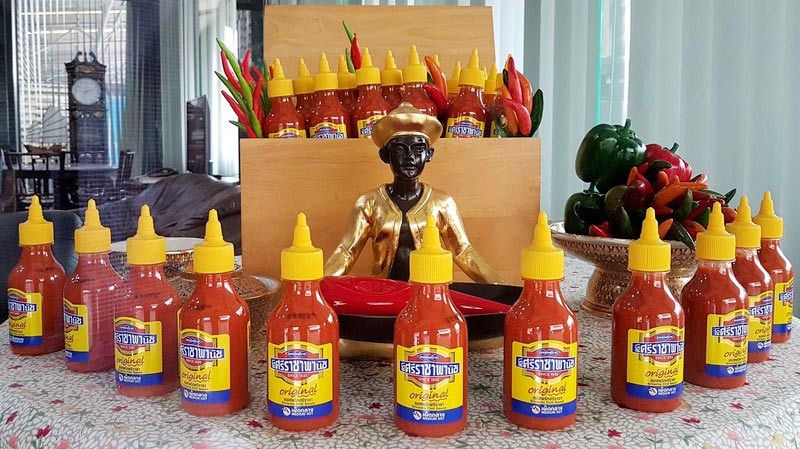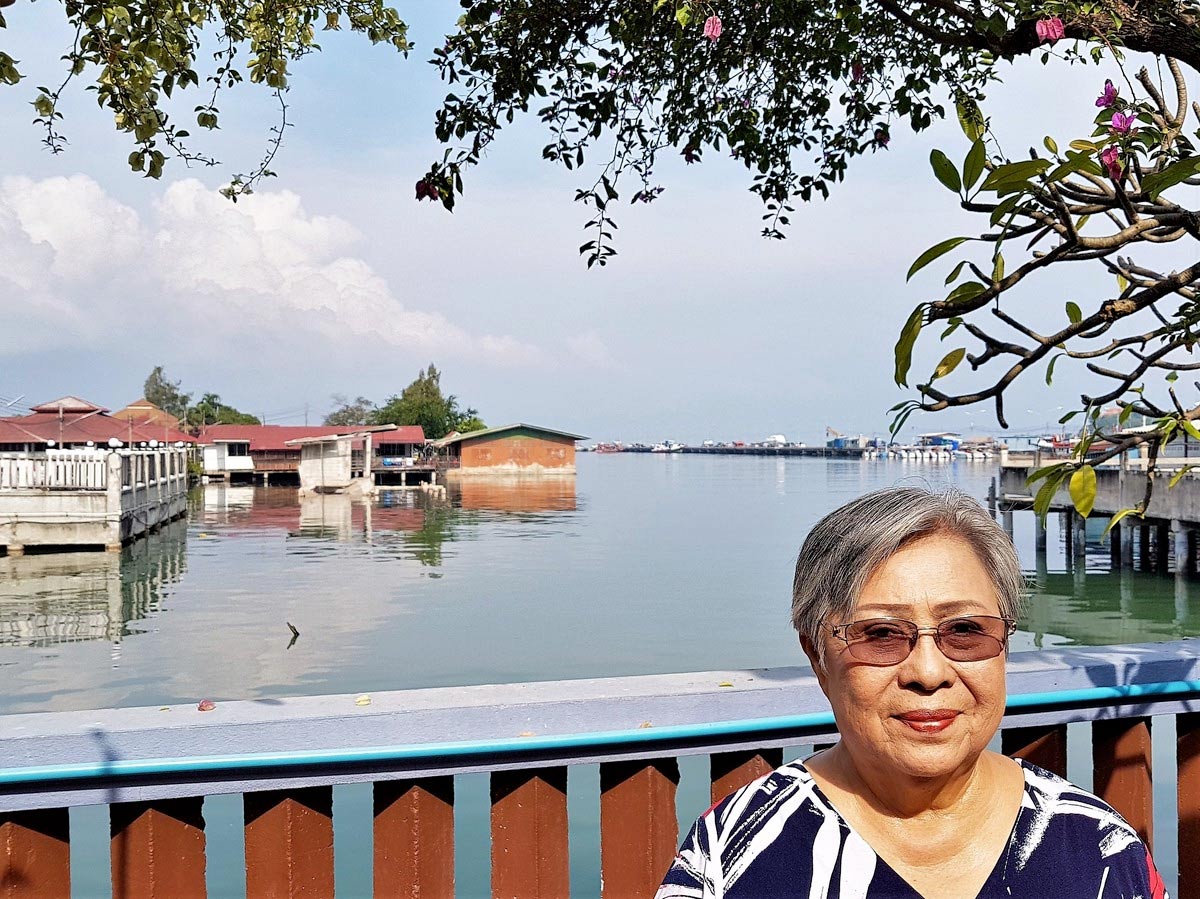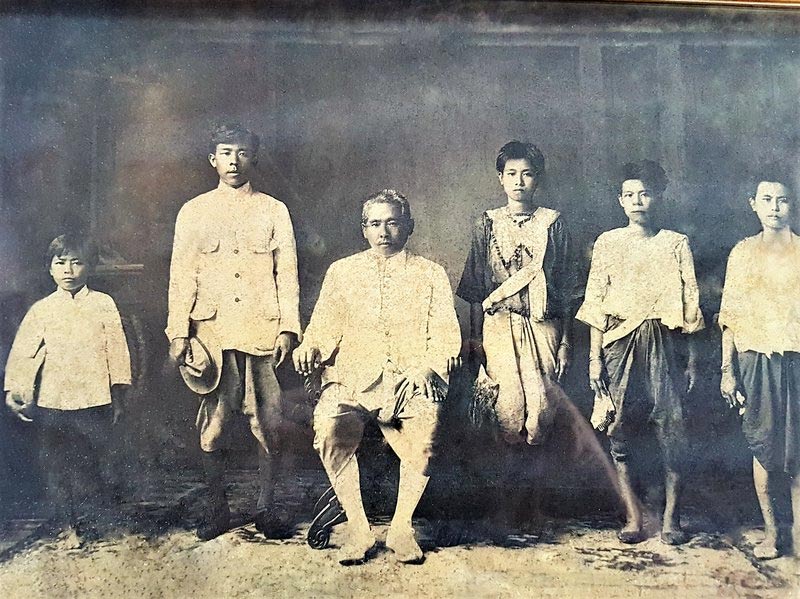 Sriraja Panich is the brand name of one of two Sriracha sauces created by Saowanit Trikityanukul's family. The family sold the brand to Thaitheparos, Thailand's leading sauce company, in the 1980s. The brand has struggled to gain a foothold in the U.S., where the Huy Fong Rooster brand of Sriracha, created by Vietnamese-American David Tran, reigns supreme.
Sriraja Panich is the brand name of one of two Sriracha sauces created by Saowanit Trikityanukul's family. The family sold the brand to Thaitheparos, Thailand's leading sauce company, in the 1980s. The brand has struggled to gain a foothold in the U.S., where the Huy Fong Rooster brand of Sriracha, created by Vietnamese-American David Tran, reigns supreme.Sriracha sauce. It's everywhere. Even beer and donuts. The fiery chili paste concocted by Vietnamese-American immigrant David Tran has conquered the American market and imagination in the past decade.
But the original Sriracha is actually Thai — and comes from the seaside city of Si Racha, where most residents haven't even heard of the U.S. brand, which is now being exported to Thailand.
I decided to go to the source to get the dirt on the sauce, and sat down with 71-year-old Saowanit Trikityanukul. Her grandmother was making Sriracha sauce when David Tran was still a baby, in what was then South Vietnam.
"If my grandmother was still alive today, she'd be 127 years old," Saowanit says, sitting in her garden in Si Racha, (the preferred anglicized spelling of the city's name) overlooking the Gulf of Thailand. She remembers helping her grandmother in the kitchen as an impatient 9-year-old.
"My job was to mix all the ingredients together. But I wasn't very happy doing it and I didn't really pay attention. I regret that now," she says. "Because I could have learned a lot."
 VIEW LARGER Saowanit Trikityanukul, 71, remembers helping her grandmother make Sriracha sauce when she was a child.
VIEW LARGER Saowanit Trikityanukul, 71, remembers helping her grandmother make Sriracha sauce when she was a child. Her grandmother is widely credited with being the first to make and sell the sauce. But Saowanit says it was really her great-grandfather, Gimsua Timkrajang, who made it first. Family lore says he traveled a lot on business to neighboring Myanmar, Cambodia and Laos and noticed they all had different sauces — sweet, salty, sour — but nothing that combined all three.
"So, my great-grandfather got an idea that he wanted to make one sauce that went along with all Thai foods," she says, "very creamy and different from other sauces."
And he got it. Not that it was easy making it. Saowanit remembers one batch that took weeks, even months, to prepare.
"We had to prepare the ingredients like pickled garlic, so we had to peel the garlic to make sure it was good," she says. "And the the chilis had to be perfectly red. And then the salt — my grandmother would only choose the big chunks and boil it, then filter and strain it ... and leave it in the sun until it dried."
The family originally made the sauce just for themselves and their friends. Then her grandmother's sister and brother started selling their own versions in Si Racha, where it's harmonious blend of chilis, garlic, salt and vinegar appeals to both locals and tourists from nearby Bangkok. But the family never patented the name.
"We didn't want to keep it to ourselves," she says, adding that it wasn't much of a secret anyway — the ingredients were there on the side of the bottles for everyone to see. Soon there were dozens of imitators in Si Racha and beyond. Including, eventually, the Terminator of Srirachas, David Tran's famous Rooster brand.
"He saw an opportunity and made his own business," she says. She doesn't begrudge him his success, but "why do they have to use our name? "Champagne is one kind of drink. Sriracha is one kind of sauce."
And the American version is very different from what's made here, she says. I've brought along a half-dozen local favorites for her to try, blindfolded, along with a bottle of the American interloper. She works her way through the Thai versions. Surprise! Her two favorites are the ones originally made by her grandmother's siblings.
 VIEW LARGER Gimsua Timkrajang, shown seated in this undated photo, was the first to make Sriracha sauce, according to his great-granddaughter. The sauce gets its name from Si Racha, the family's seaside hometown in Thailand.
VIEW LARGER Gimsua Timkrajang, shown seated in this undated photo, was the first to make Sriracha sauce, according to his great-granddaughter. The sauce gets its name from Si Racha, the family's seaside hometown in Thailand. I'm still impressed, though, that she can tell them apart blindfolded. They taste exactly the same to me. When it comes to the Rooster brand? After a tiny spoonful, she draws a sharp breath.
"It's not tasty," she says, taking a sip of water. "It's not mixed together properly. There's only one taste." Saowanit says a proper Sriracha sauce needs to be what Thais call klom klom — the hotness, the sour, the sweet and the garlic all blending together seamlessly, none overpowering the other. The American version, she says, just brings heat.
I test her theory at a nearby restaurant where the lunchtime crowd is digging into their food. They seem surprised to learn there's an American Sriracha. Tanpatha Punsawat is first on the spoon. "It's hot," she says carefully. "Very hot."
But is it good, I ask?
"It's OK," she says politely. ( Loosely translated, her facial expression was "ugh.") Her dining companion, Chuwet Kanja, tries next, rolling the Rooster around in his mouth. "No good," he says, making a face. "When I first tasted it, I wanted to gag. Too bitter. It's not klom klom." I give him a spoonful of the leading Thai brand. He smiles and gives it a thumbs up. Order restored.
Reactions like these haven't stopped importer Super Ting Tong from bringing the Rooster Brand to Thailand. And it's showing up on more and more tables at upmarket eateries and on supermarket shelves in the capital, Bangkok.
"You know, it's not an overnight success, but that's OK, we're working more on the slow and steady progression," says Robert Booth, one of the founding partners of Super Ting Tong, who says the company has imported two container loads of the Rooster brand to Thailand in the past year and change. That's about 60,000 bottles — enough to convince the company to order more. Super Ting Tong is a tongue-in-cheek name that roughly translates as "Super crazy" in Thai. And Booth admits the idea of importing Sriracha to Thailand has been met with some resistance.
"You occasionally run into some people who have very strong views about the Rooster brand not being the original Thai Sriracha, mostly the kind of angry Facebook trolls you would expect, " Booth says. "But, given the love of spicy sauces and spicy foods in Thailand, I think there's more than enough room to incorporate a new player in the market."
Leading Thai manufacturer Thaitheparos, which bought the Sriraja Panich brand from Saowanit Trikityanukul's family over 40 years ago, knows about slow starts. It has been exporting their Sriracha to the U.S. for more than a decade. It hasn't been pretty.
"We try to tell people we're the original Sriracha from Thailand," says Varanya Winyarat, deputy managing director of Thaitheparos. "But when Americans try Sriracha sauce, they try the Vietnamese-American one first, so they think the taste should be like that."
She's frustrated and thinks maybe her father, who runs the company, should shell out more money for advertising and a new distributor. "Now we only sell in Asian supermarkets. We have to go mainstream," she says.
"I think I have to educate them first what the sauce should taste like," she says, adding, "you have to educate them about the basics of the taste first. Then I think they would understand. "
She's not worried about the American Sriracha eating into market share here—"Thai people understand the real taste," she says, almost dismissively.
But she admits David Tran's Rooster brand has already crushed her hopes of conquering the U.S. market. But Varanya and export manager Paweena Kingpad say world Sriracha domination may still be in sight because of strong sales in another global Sriracha superpower: China.
"China is a big market for us — the biggest market, 100,000 bottles a month," Paweena says.
When asked why their brand is doing so well in China, the two women look at each other and smile. "Because Asian people know how to eat," Varanya says, giggling.

By submitting your comments, you hereby give AZPM the right to post your comments and potentially use them in any other form of media operated by this institution.